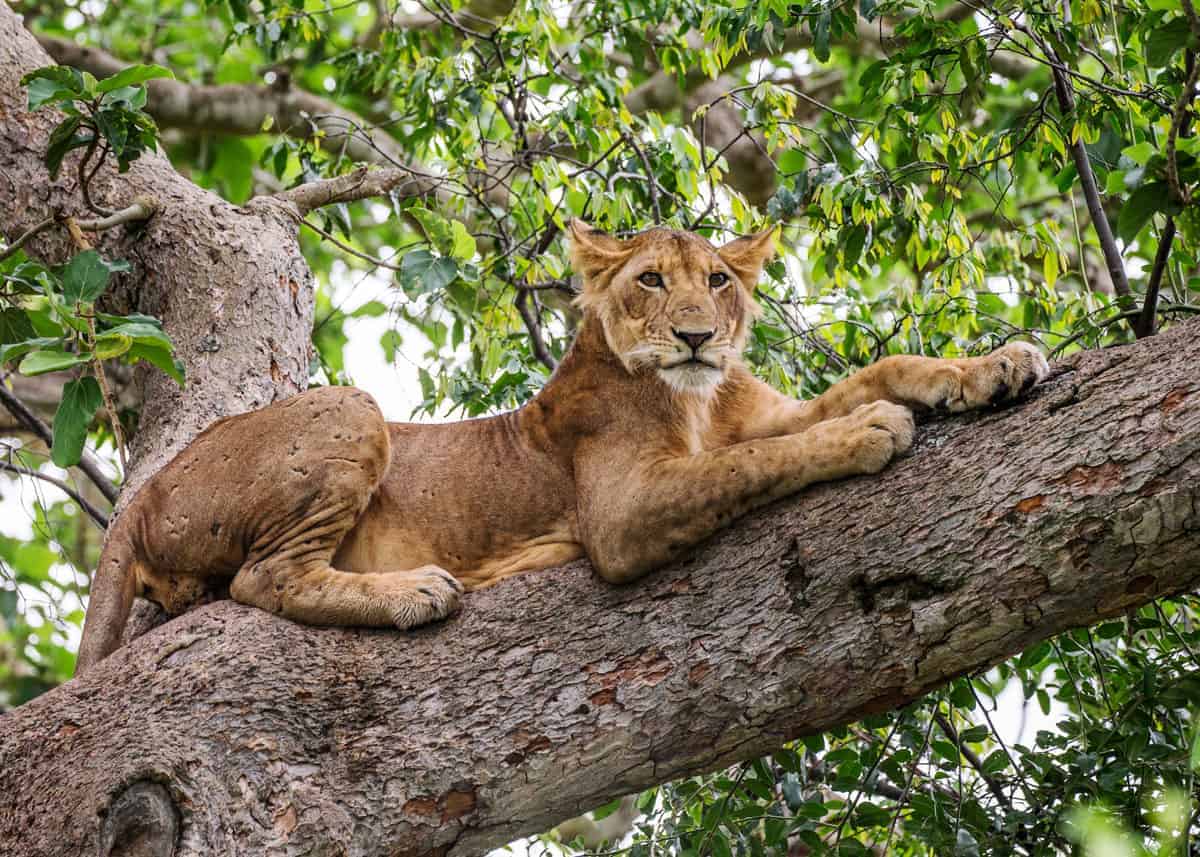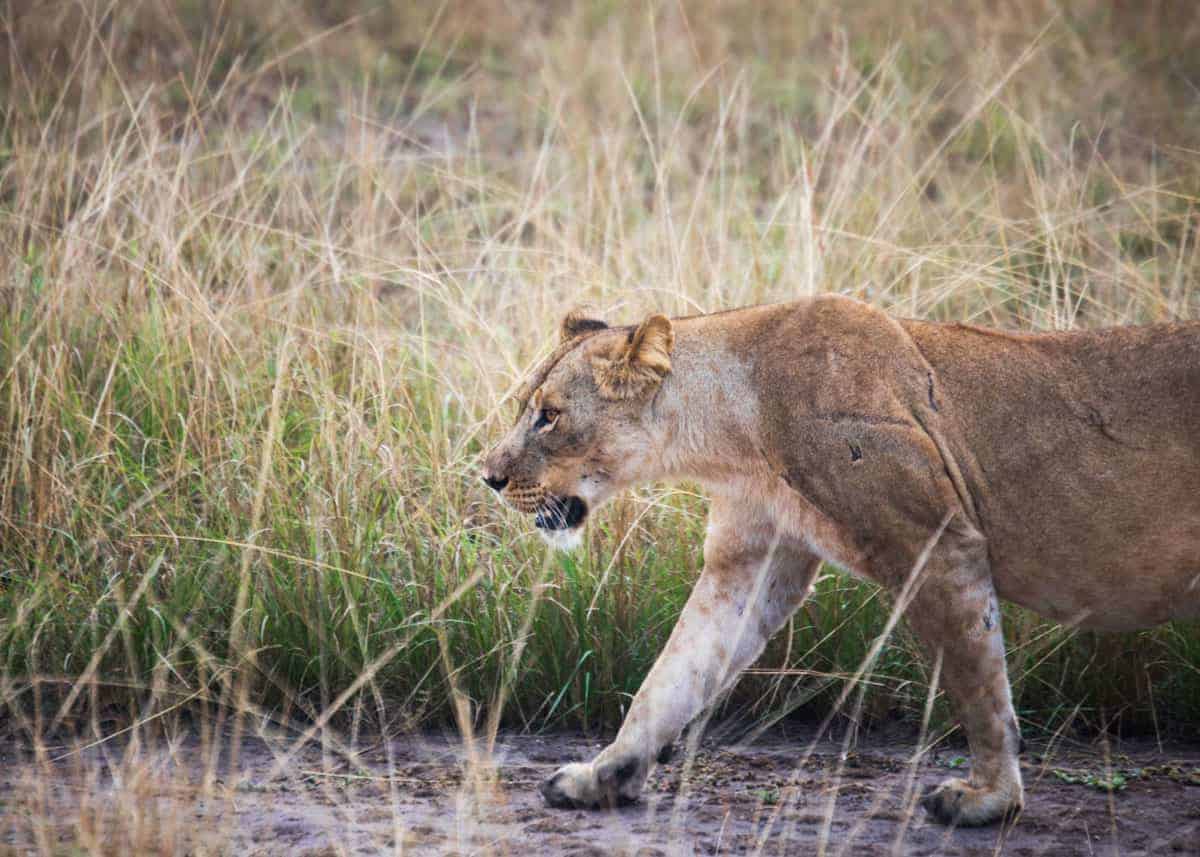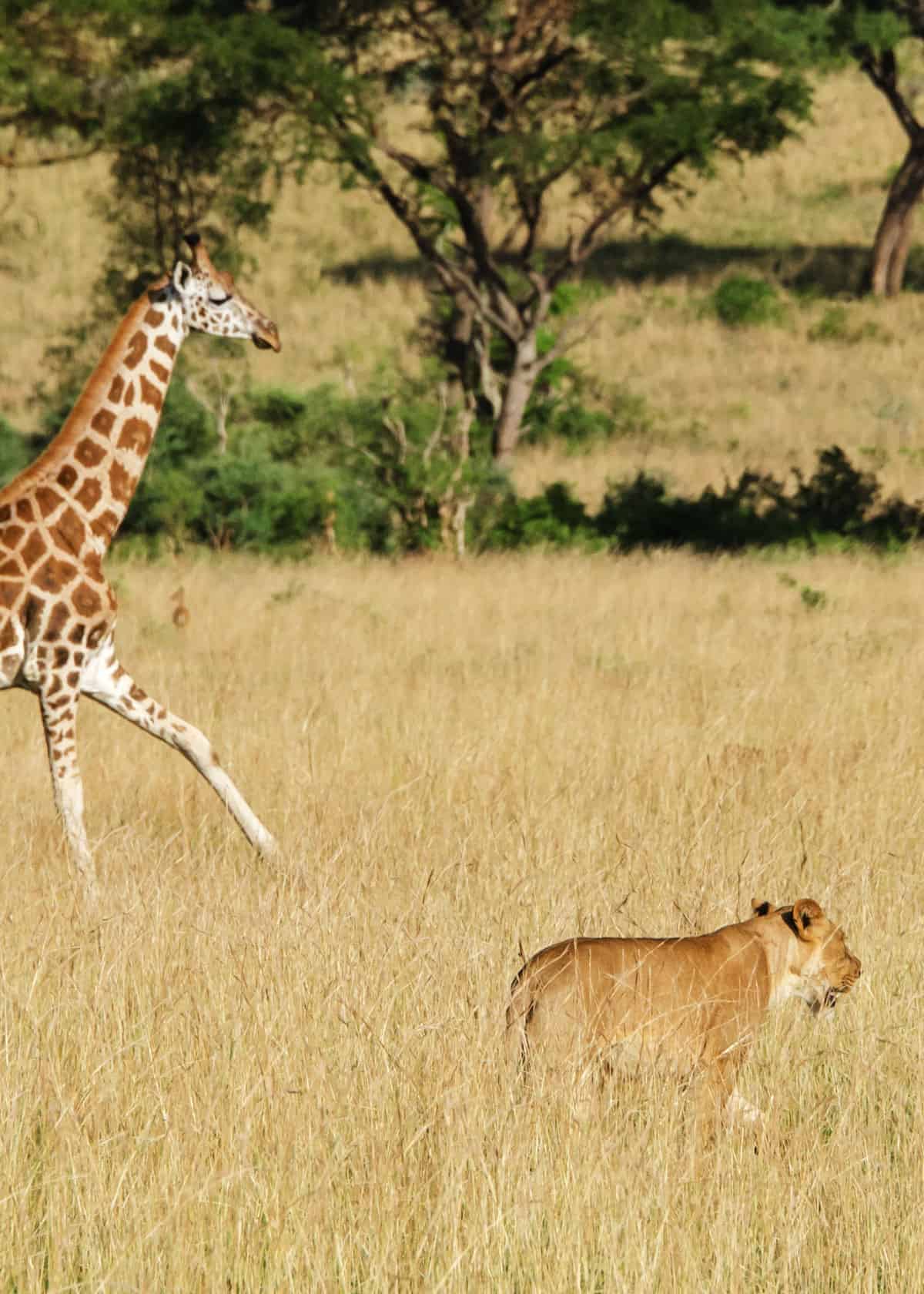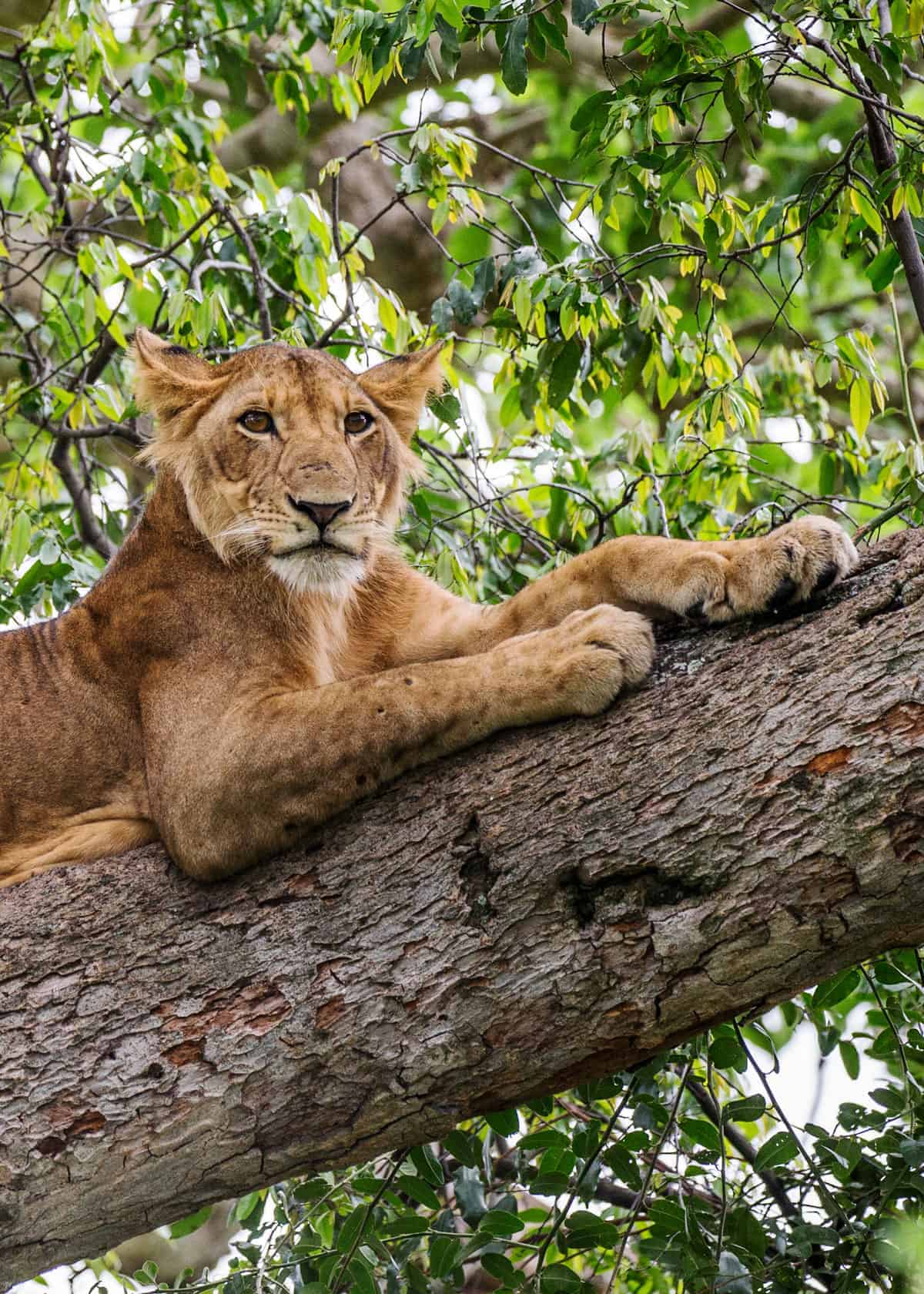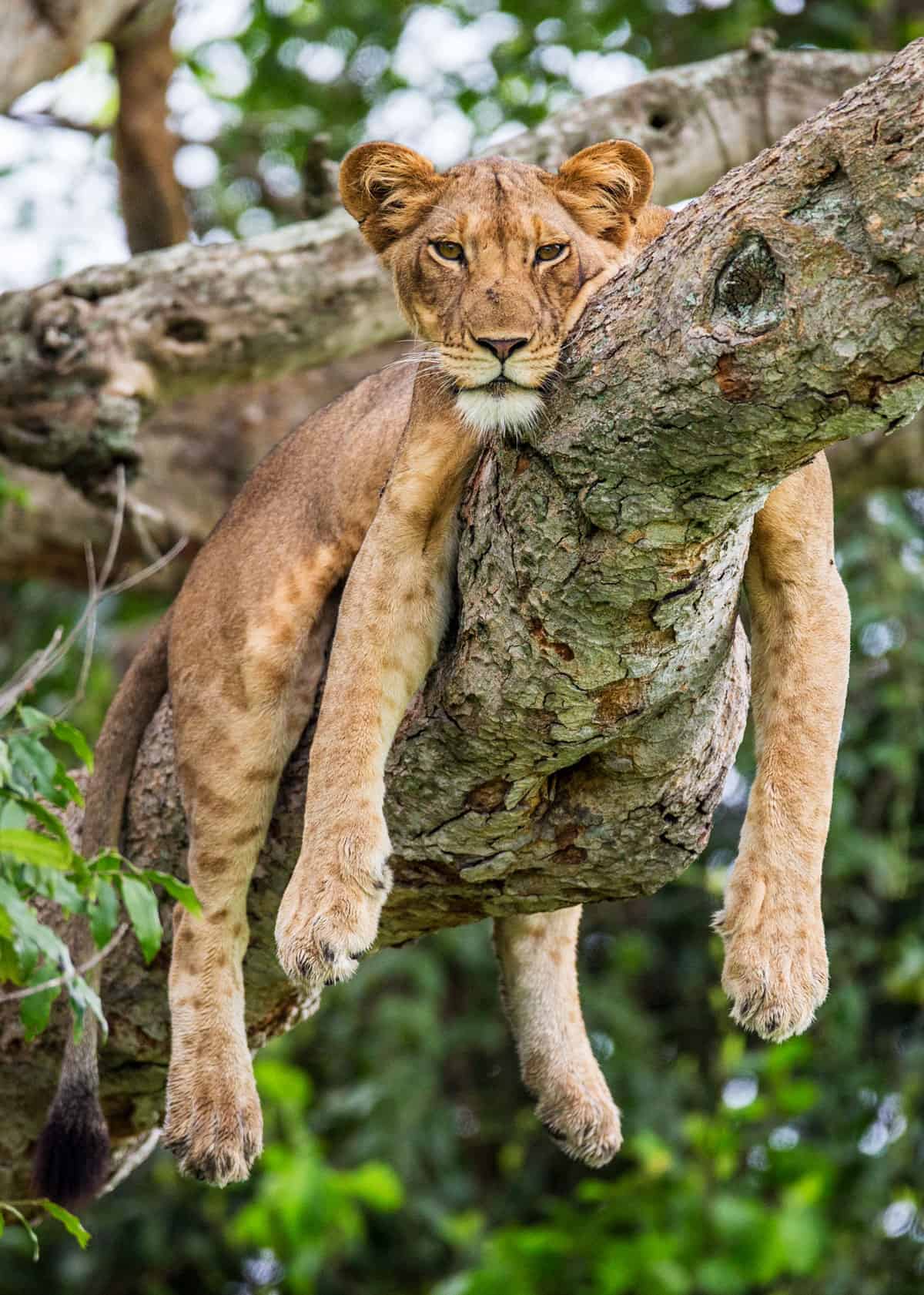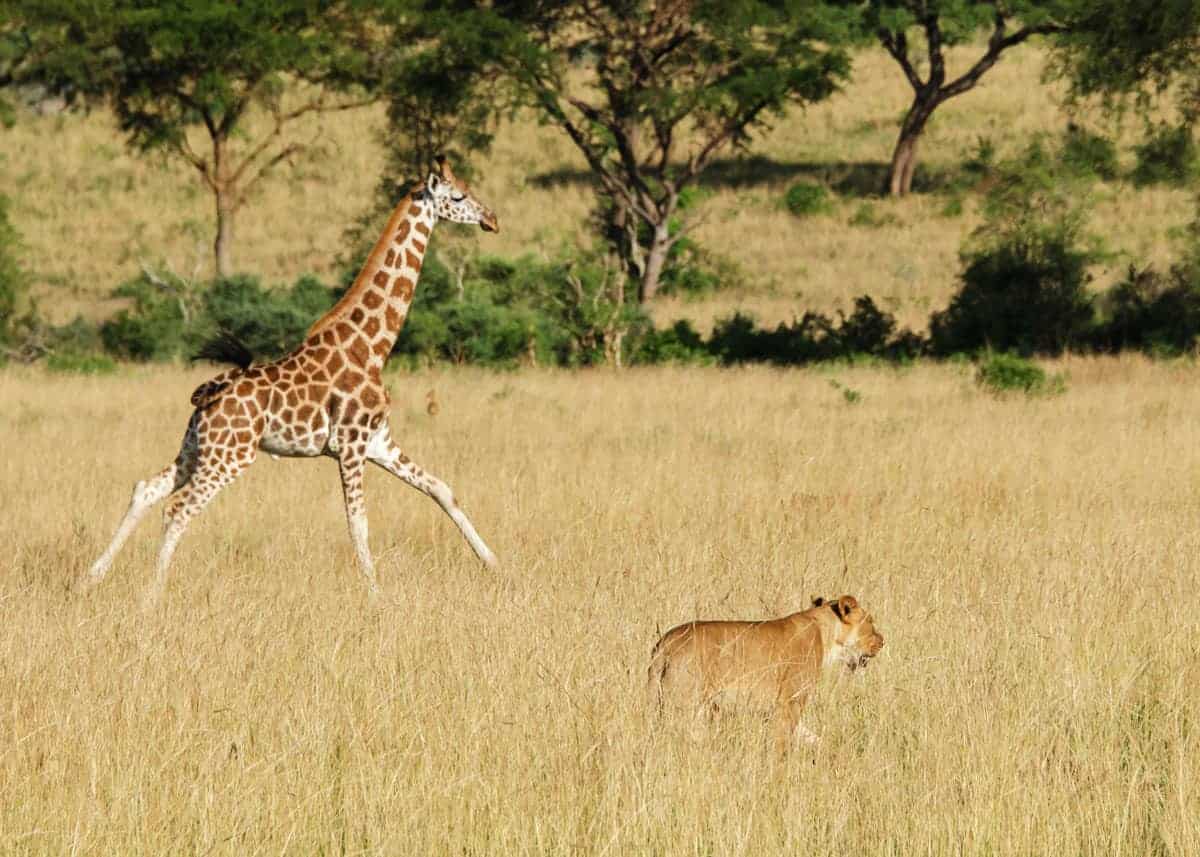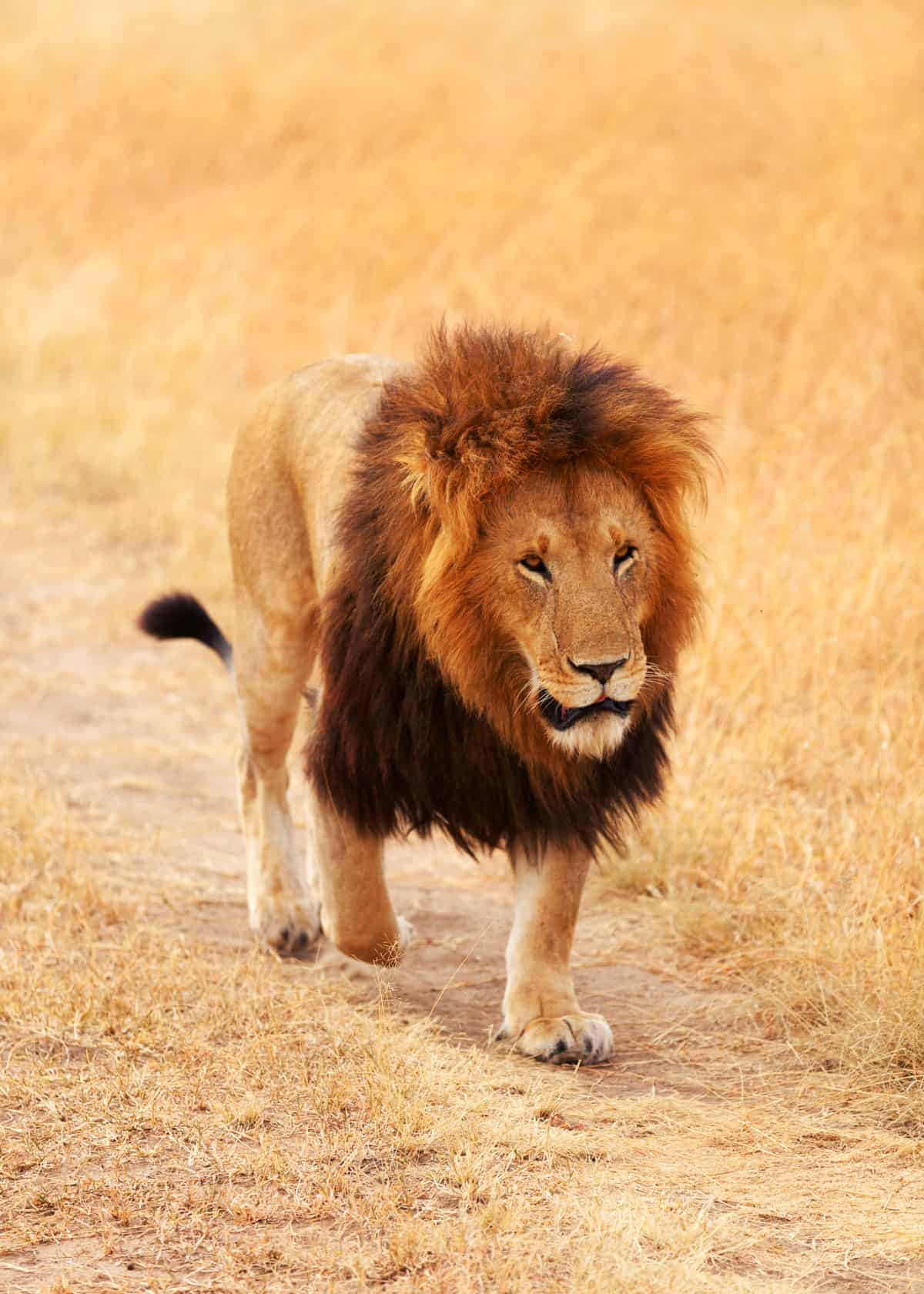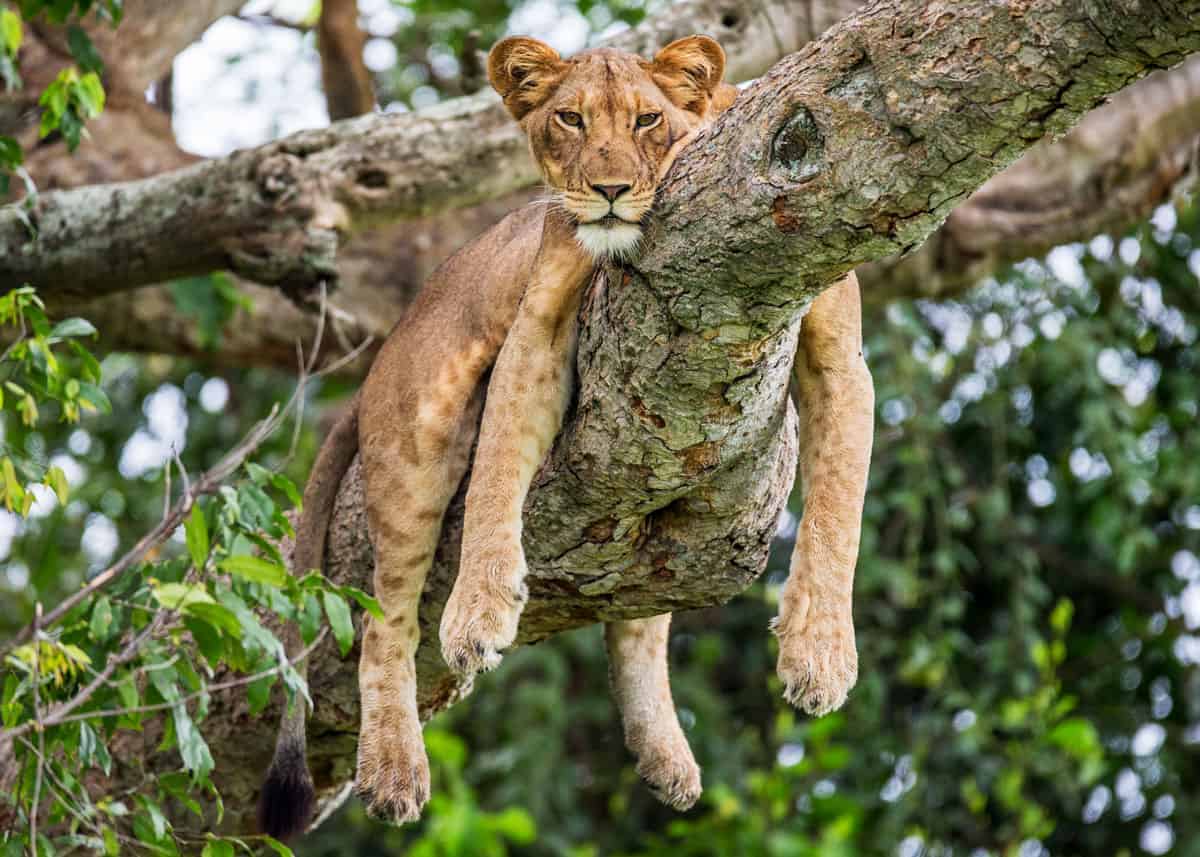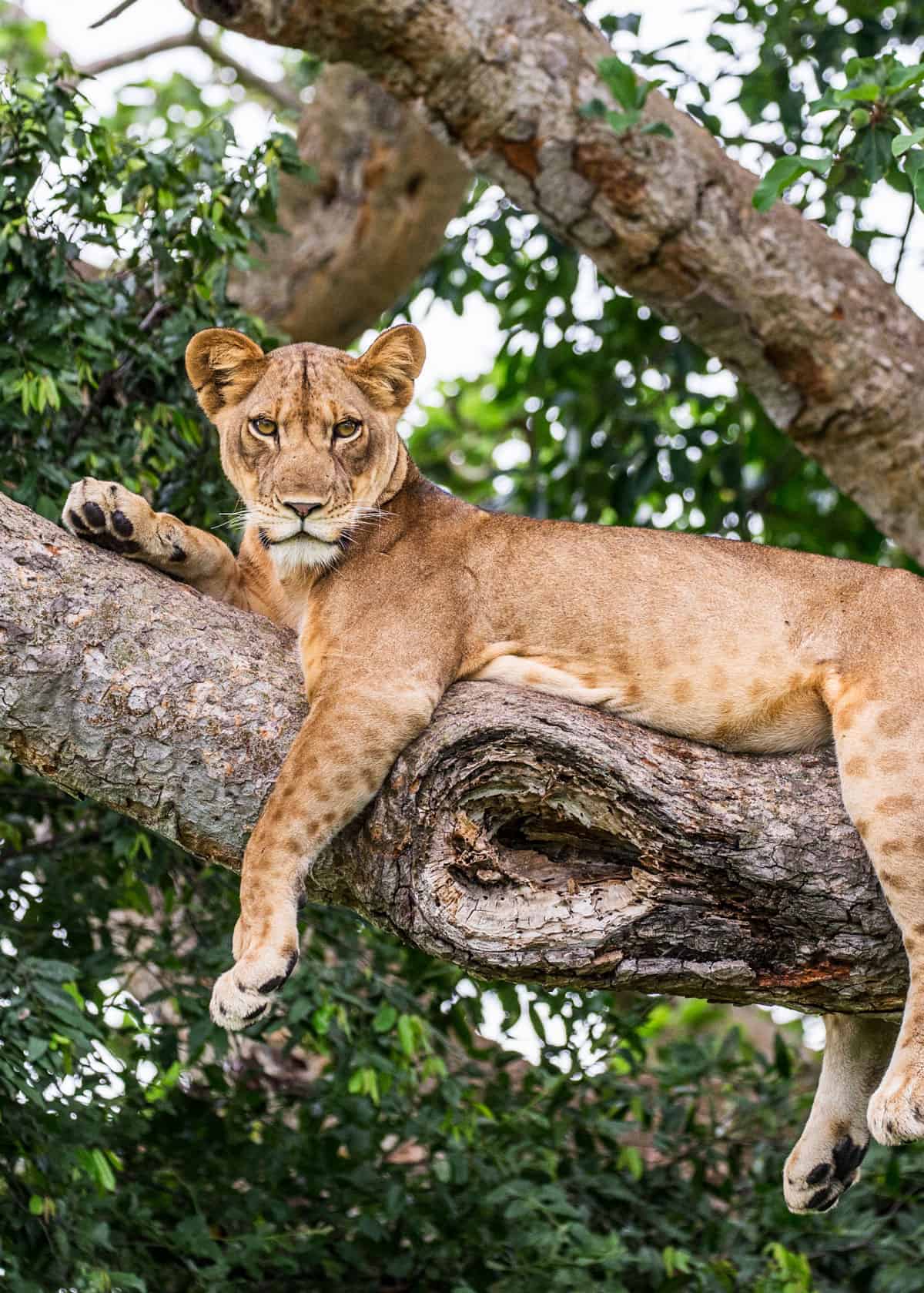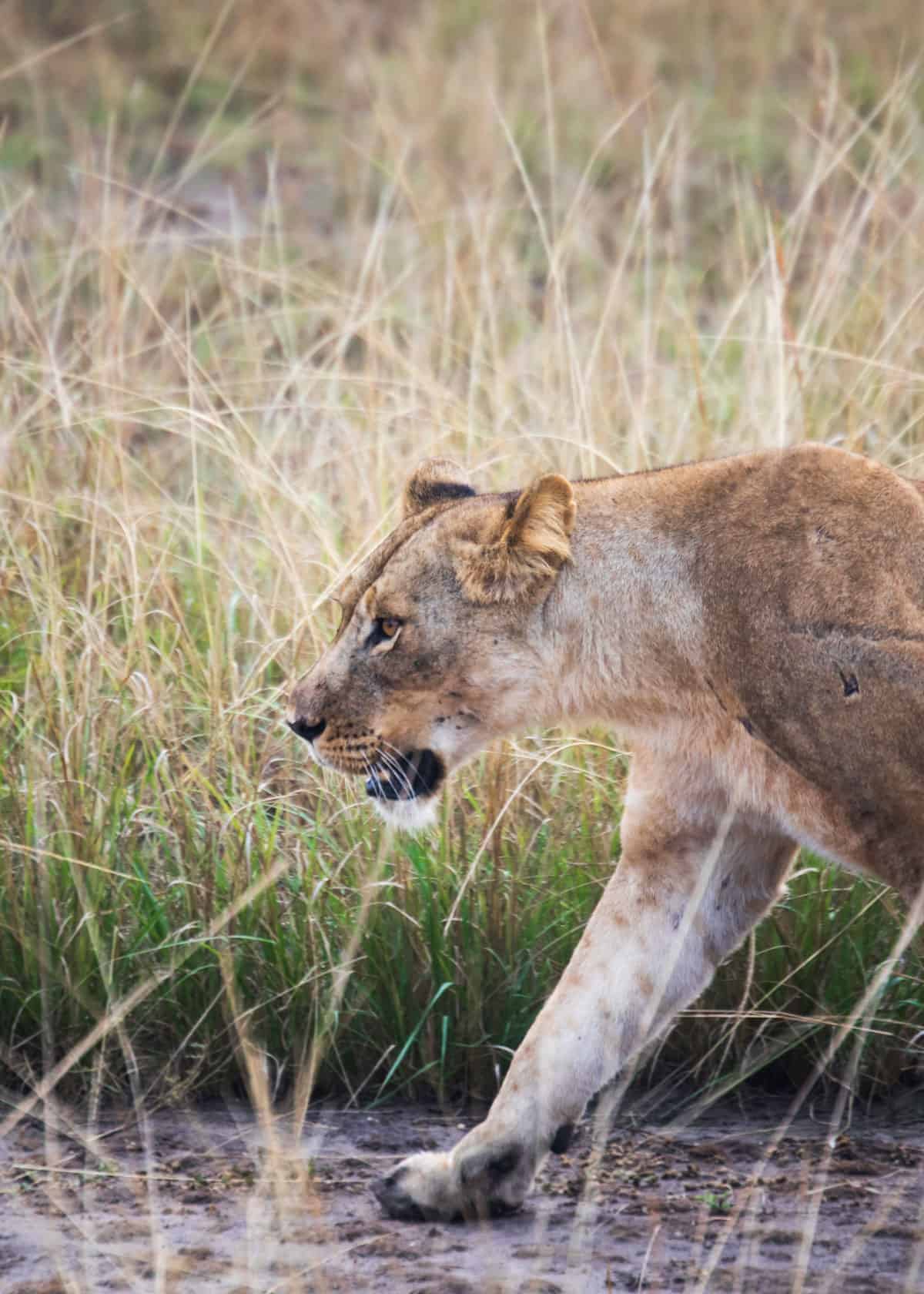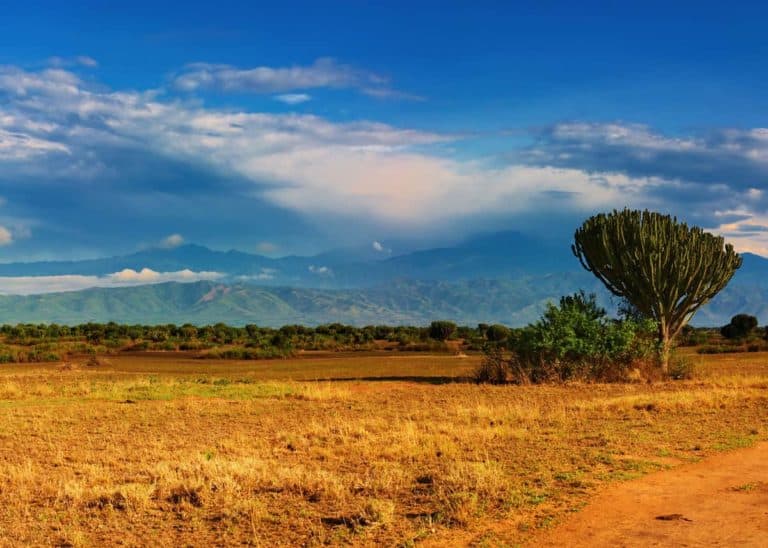36 Facts About African Lions (Panthera leo)
In this post, you’ll learn 36 facts about African lions. They are the world’s most iconic cats and one of the most famous African animals. You’ll learn about their habits, habitat, diet, differences with other lions, and much more. Plus lots of photos and an amazing video!
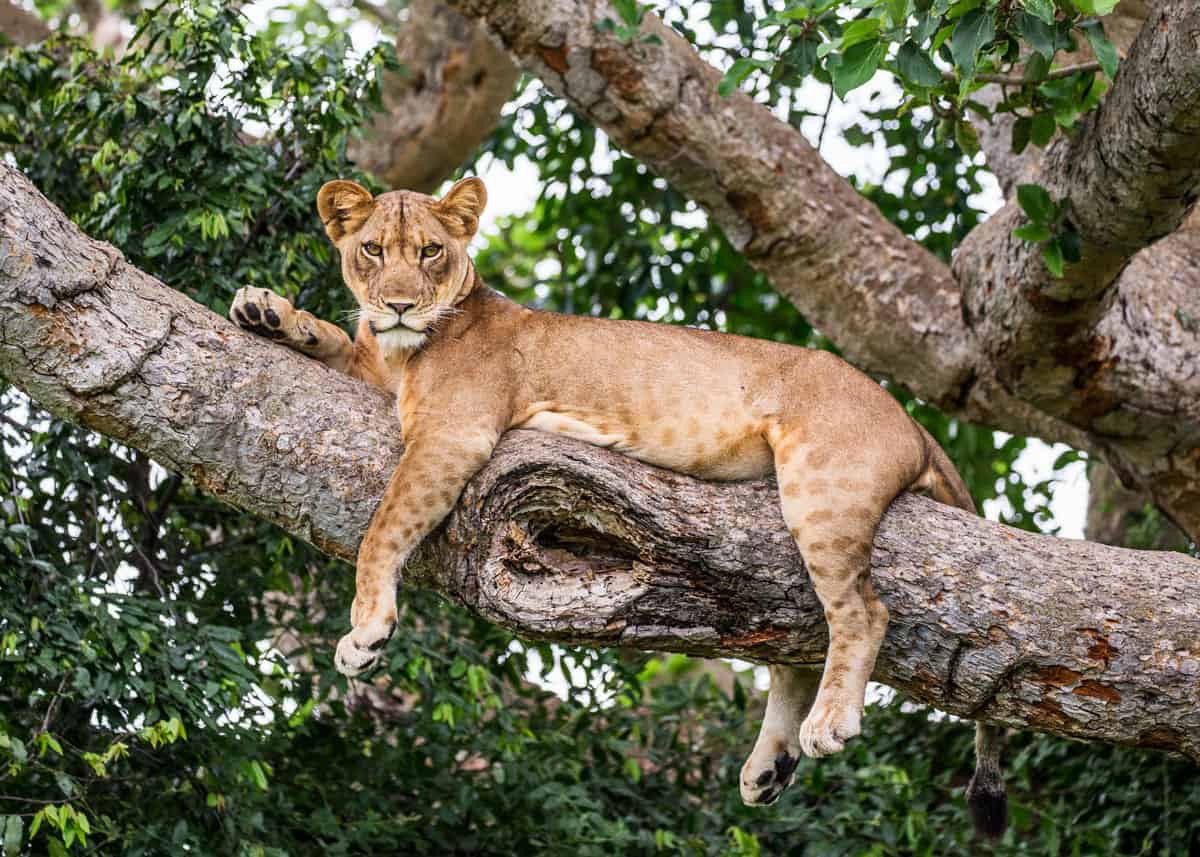
36 Facts About African Lions
The African lion is one of the most recognized animals in the world.
Famous for everything from its shaggy mane to its jaw-cracking roar, it’s an iconic symbol of strength, pride, loyalty, royalty, and fierceness.
But how much do you really know about the African lion? Are you able to tell fact from fiction?
Let’s test your knowledge. Here are just a few African lion facts for your perusal.
1. Where do African lions live?
African lions live in East, West, South and Central Africa. There are no species in the north. They’re sub-Saharan animals, meaning that they live below the Saharan Desert.
As for the countries that they roam, it’s a mixed bag. The lion population has declined so dramatically over the years that wild lions are functionally extinct in dozens of African countries, but they can still be found in zoos, nature reserves and national parks.
There have also been reports of wild lions popping up in unexpected places and scaring the life out of local residents. They definitely like to keep people on their toes.
See the tree-climbing lions of Queen Elizabeth National Park, Uganda. They appear at about 3:45 in the video.
2. How many African lions are left in the world?
It’s estimated that there are around 23,000 – 39,000 lions in the world. The grand majority are in Africa with a small percentage located in India. The most critically endangered species is the West African lion; there are less than 400 remaining.
In their prime, there were as many as 200,000 wild lions roaming the whole of the African savanna, but their numbers and ranges are only a fraction of what they used to be.
Take a look at their distribution map. The red is where they used to live; the blue is where they live today.
3. What country in Africa has the most lions?
If you want to see wild lions in the flesh, you’ll need to travel to South and East Africa. Countries like Tanzania, Kenya, Botswana, Namibia, and Zimbabwe have the largest lion populations.
As for protected lions, they can be found in places like the Masai Mara National Reserve (Kenya) and Etosha National Park (Namibia). You can also take safari circuits around Serengeti National Park (Tanzania) to spot them.
4. What types of lions live in Africa?
This can get a bit complicated, so buckle up.
Lions as a species are classified as panthera leo. This is the umbrella term for all lions everywhere.
As for African lions, they come in two subspecies:
- Panthera leo leo (found in West and Central Africa)
- Panthera leo melanochaita (found in East and Southern Africa)
These two species can also be broken down into categories like “Masai lion” and “Ethiopian lion.” Each category used to have its own scientific name, and it isn’t uncommon to see older books and websites list them as panthera leo krugeri, panthera leo vernayi or panthera leo massaica.
In 2017, however, the Cat Classification Task Force looked at blood samples and realized that all of these fiddly little categories were meaningless from a chromosomal standpoint. African lions only had two types of DNA between them.
So, from an official and scientific standpoint, there are only two subspecies of African lions: P. l. leo and P. l. melanochaita. But it’s still common to see people talking about others.
5. What is the habitat of the African lion?
African lions live in grassy plains and savannas. They aren’t afraid of bleached yellow fields with the sun beating down on them.
At the same time, however, they like to stick close to water sources like lakes, rivers and streams. They also like the dense cover provided by trees and bushes; it’s common for lions to drag their prey into these secluded areas so that they can chow down in peace.
6. What do African lions eat?
African lions are carnivores. They eat deer, Cape buffalo, zebra, wildebeests, waterbucks and even baboons. Occasionally, a pride will take down an elephant or giraffe, but this is rare.
Lions generally prefer bigger prey to smaller prey, and they like to hunt free animals in wide, open spaces. They only go after livestock if food is scarce in their region.
For example, farmers in Cameroon have reported that lions only feed on their cows and goats during the rainy season when they can’t find food elsewhere.
7. How often do lions feed?
Lions feed frequently; they’re a lot like humans in the sense that they can’t run on fumes for long. They might last anywhere between 10 – 14 days without food before their bodies start to break down.
When they do eat, however, they feast. Their average intake is around 10 – 20 pounds of meat per day, and this isn’t taking into account the times when they gorge.
If they take down a large animal or herd, lions will stuff themselves silly. Males can consume up to 95 pounds at a time; females can eat more than 55 pounds.
8. How does a lion attack its prey?
The first thing to know about lions is that they hunt in groups. They’re unlike every other “big cat” species in this regard; African leopards and tigers hunt alone, but the lion almost always has a pride.
They generally find and stalk their prey around the water sources where they congregate. The other animals come in for a drink, and the lions attack.
They aren’t very subtle about it. Lions aren’t sneaky ambush predators who lie in wait before striking at an opportune moment.
Instead, they charge right in for the kill, and they don’t care if their prey is in a large group. They’ll simply cause a mass panic and use the ensuing chaos to isolate and overwhelm a slow member of the species.
This is where their teamwork comes in handy: Once they lock into their prey, they can encircle it and keep it from escaping.
Some prides even use the same left and right “wing” formations every time that they attack.
9. What happens when a lion finally catches its prey? Why do they bite the neck?
Lions use their front and back paws to subdue their prey by knocking it off-balance. They might also jump on top of the animal and use their body weight to wrestle it to the ground.
If they have a clear shot at the neck, they’ll take it; otherwise, they’ll bite the face, nose, mouth and throat over and over.
This is to suffocate the animal while also keeping the lion clear of any horns or hooves that could hurt them.
10. How do lions eat their prey? Is there anything that a lion won’t eat?
Lions dig into the stomach first. They open the animal’s abdomen and eat its entrails.
They’re fond of hearts, livers and kidneys, but they’ll eat almost anything except for the skull and brain. It’s rare for lions to find those tasty. They’ll leave them for another scavenging predator.
11. How dangerous is the African lion? Is it an aggressive species?
African lions are extremely dangerous.
Their size and strength make them one of the most formidable hunters in the animal kingdom, and they have naturally aggressive personalities that often cause fights even among members of the same pride.
They might work together to take down a warthog, but once the warthog is dead, it’s every cat for himself. Smaller and weaker lions might not get a chance to feed at all. Even mothers have been known to leave their cubs hungry in favor of feeding themselves.
12. Will a lion attack a human? Do lions eat humans?
Yes.
While lion attacks are rarer than you might expect from sensational media coverage, it’s still something that can and does happen. It’s estimated that anywhere from 50 – 100 people are killed by lions every year.
The deaths are usually the result of defensive or territorial behavior on behalf of the lion. It’s unusual for lions to stalk humans as prey.
When they do go after humans, however, they tend to be prolific about it. Man-eating lions have been known to stalk specific villages or work sites for months on end.
They don’t actually “develop a taste for blood,” but they’re smart enough to recognize a stable food source when they see one, so they’ll linger in an area and kill literally hundreds of people until they’re driven off.
13. What are some famous examples of lion attacks?
The craziest lion attacks in the world come from the Tsavo Man-Eaters. They were a pair of lions that terrorized a construction project in the Tsavo region of Kenya and Uganda.
For nine months, they dragged men off in the middle of the night to kill and eat them. The final death toll was around 135 people.
Another dangerous group of lions were the Njombe Lions. Over the course of three generations, they killed between 1,500 – 2,000 people in the Njombe region of Tanzania. They were active for decades before they were finally eradicated.
You might also have heard of the Game of Thrones editor who was killed while on safari in South Africa. She’d rolled down her window to take pictures, and a lion reared up next to her vehicle and killed her. It was a tragedy that made headlines all over the world.
14. Are lions endangered?
While not quite endangered, lions are listed as “vulnerable” by the International Union for Conservation of Nature (IUCN). Their population is on the decline, and they’re considered functionally extinct in many areas of Africa where they used to be quite frequent. It’s estimated that their numbers fall between 30 – 50 percent every couple of decades.
The situation is even worse for the West African lion. It’s considered “critically endangered” with an extremely low number of sexually mature adults who are able to reproduce.
These lions are the focus of several different conservation efforts to preserve their species.
15. When did the lion become endangered?
There’s no exact timeline for the decline of the African lion. In fact, this lack of detailed data is part of the reason why the problem got so bad in the first place.
For most of the 20th and 21st century, lions weren’t tracked or monitored by advocacy groups. They seemed to be thriving, and there were plenty of zoos, circuses, reserves and national parks that had lion populations.
It wasn’t until recently that people realized just how much the population and range of the lion had decreased. Instead of flourishing in their scattered locations, they were actually dying out. They weren’t being shared, traded or bred fast enough to maintain a stable population.
According to the African Wildlife Foundation, lions have lost 85 percent of their natural range in the past century.
16. How many lions are left? How many of them are African lions?
According to the IUCN, there are 23,000 – 39,000 African lions in the world. Only 400 or so are West African lions, and less than 250 of those lions are mature adults.
To protect their dwindling numbers, most West African lions are kept in federally-funded national parks and nature reserves. They can be found in places like Chad, Benin, Burkina Faso, Cameroon, Namibia and Niger.
If that sounds like a lot, however, you should know that their population in each country can be measured by the dozen. There’s a reason that West African lions are critically endangered.
The good news is that the lion species as a whole is hanging in there. They’ve even managed to surprise animal experts every now and then.
- In 2015, for example, a group of 200 lions were found wandering through a national park in Ethiopia. Wild lions were thought to be extinct in that country, so it caused quite a stir.
- The same thing happened in Ghana later in the year; a male and female lion were spotted in a national park. It was the first time that wild lions had been recorded in Ghana for 39 years.
17. How big are African lions? How much do they weigh?
African lions range from 8 – 10 feet with an average body weight of 320 – 420 pounds. This is the same for both panthera leo leo and panthera leo melanochaita even though the former is usually a bit smaller than the latter. Males are always bigger than females.
As for record-breaking felines, the largest verified African lion measured 10.9 feet, and the heaviest weighed 690 pounds. The fat lion was a known man-eater.
It’s a bit gruesome to think about how he put on the weight.
More reading: Can an ostrich kill a lion?
18. What does an African lion look like?
African lions are light yellow to dark brown. They have thick, sturdy bodies with muscular limbs. Their snouts are elongated and topped with whiskers. Like other lions, the males have manes.
A surprising fact about manes is that they can be different lengths and colors. Some lions have short, choppy manes; others have long, luxurious manes. Their colors include yellow, brown, beige and reddish.
Research suggests that the appearance of a lion’s mane might have to do with his fighting prowess. Older, stronger lions tend to have movie-worthy manes while young and weak lions are more ragged.
19. What did extinct African lions look like?
The “Cape lion” had a black mane that extended across its entire torso from the shoulders to the belly.
The “Ethiopian lion” had a dark brown mane with black tips. There’s also some artwork from ancient Egypt where the lions are depicted with no manes at all. It’s a shame that we’ll never get to see these specimens in real life.
20. Are white lions real?
Yes. White lions are a type of South African lion that are highly prized for their unusual appearance. They aren’t albino; they were simply born or bred with recessive genes. Their coloring can range from a blondish yellow to a true white.
The rarest lion of all is the blue-eyed white lion. They’re so striking that African tribes have worshiped them as gods or the favorites of the gods.
One legend has it that white lions were the first animals to be created, so they’ll be the last animals to die. When all other life has ended, the roar of the white lion will be the last thing ever heard in the world.
21. What are the differences between Asian lions and African lions?
The easiest way to differentiate between Asian and African lions is by looking at their bellies. The Asian lion has a vertical “fold” of skin that runs along its stomach, and this feature isn’t present in African lions.
Aside from that, African lions are bigger and stronger than Asian lions. They also have larger manes and tails.
One interesting thing to note about Asian and African lions is that they can’t be cross-bred. A disastrous attempt was made in the ’80s, but it produced weak, sickly hybrids that didn’t survive for very long.
Even though other cats like tigers and leopards can be cross-bred with different types of their own species, Asian and African lions simply don’t mix.
22. What’s the lifespan of the African lion?
It’s difficult to determine the lifespan of an African lion because they rarely die of natural causes. However, it’s generally agreed that they live between 10 – 15 years in the wild.
In captivity, they can last around 20 – 25 years. According to the Animal Aging and Longevity Database, the oldest lion ever recorded was 27 years old when he died. He lived in a zoo.
23. What do you call a group of lions? How large are these groups?
A group of lions is called a pride. They can grow as large as 40 lions in a single pride, but the average is closer to 13 – 15. They don’t spend all of their time together; it’s common for smaller groups to wander off and hunt, roam, mate and play. Females drastically outnumber males in every pride.
24. How many male lions are in a pride? Can there be more than one?
There are usually 2 – 3 males in every pride with 10 – 12 females. The females are all related, but the males will break away or be forced away from the pride when they start to mature.
They might survive as solitary animals for a while, or they might form “coalitions” with other unattached males.
When they reach full maturity, they’ll forcibly fight and take over another pride.
25. How old are male lions when they leave the pride?
Male lions are usually around 2 – 3 years old when they leave their pride, and they’re 5 – 6 years old when they start challenging the males of other prides.
However, it’s important to understand that lions aren’t like wolves. There’s no “alpha” or “dominant” male that rules over everyone.
The males in a pride might attack each other for food or mating rights, but these conflicts are rarely fatal, and the beaten lion will simply lick his wounds for awhile before issuing another challenge.
The next time, he might win the fight and be the first one to eat a liver or mate with a female. The hierarchy of a pride can be quite flexible in this way.
26. What happens during a takeover? Is it true that male lions kill the cubs?
Yes. Incoming male lions will slaughter the cubs of the pride that they’re taking over.
When a male lion successfully fights and integrates with a new pride, one of his primary goals is reproducing as quickly as possible.
A quirk of lion mothers is that they aren’t interested in re-mating until their cubs are around 18 months old, but they’ll re-mate in days if their cubs are lost or killed.
So, to expedite his own reproduction, a male will kill the existing cubs in a pride and free up the mothers for mating.
27. Do the mothers attempt to save their cubs?
They might have the occasional moment of selfishness over food, but female lions will fiercely defend their cubs during a takeover. They’re usually joined by other mothers and females in the pride.
In fact, some prides have “creches” of mothers that communally raise and nurse their babies, and if they’re attacked by an incoming male or male coalition, they’ll work together to drive them off.
28. Do male lions hate cubs in general?
No. The Lion King didn’t lie to you; adult male lions can be very affectionate towards their offspring, allowing them to play with their manes or nip at their tails.
It just has to be their offspring and not another males. Remember this fact the next time that you judge Scar for hating Simba.
29. Do African lions have any mating rituals?
African lions reach sexual maturity between 3 – 4 years for females and 5 – 6 years for males. They’ll mate at any time of year, so there’s no particular season or month for it.
They’re also a bit like rabbits in the sense that they just don’t stop once they get going. A pair of mating lions will join together between 20 – 50 times per day!
30. How often do African lions give birth? What’s the process like?
Female African lions generally breed every two years or so. As previously discussed, they won’t be interested in new males until their cubs are around 18 months old, so that’s a mandatory break in the mating cycle unless their cubs are lost or killed.
They generally break away from the pride after getting pregnant. They’ll set up a den in a secluded cave or thicket, and after 3 – 4 months, they’ll give birth to anything from a single cub to a small litter.
31. How long does the African lion cub stay with its mother?
African lion cubs are completely dependent on their mothers after birth. They’re born blind, only opening their eyes after a week or so, and they can’t walk for close to a month.
As you might imagine, this leaves them extremely vulnerable to predators. From scavenging hyenas to takeovers from unattached male lions, they’re helpless before the dangers of the world. It’s estimated that 80 percent of lion cubs don’t make it to adulthood.
Mothers will return to their pride when their cubs are 6 – 8 weeks old. If any creches exist, she’ll join them. Female cubs grow up and stay with their pride; male cubs grow up and set off to challenge others.
32. What threats face the African lion?
Hunting is the single biggest threat to the African lion. They’ve been considered trophies since ancient times, and their bones and body parts are used in a variety of foods, medicines and fashion accessories.
It’s illegal in many African countries to kill a lion, but that doesn’t stop people from doing it. Farmers shoot or poison lions in retaliation for killing their livestock; hunters come to Africa for the glory of killing big game.
There’s also a booming trade industry for lion parts. Between 2008 and 2016, more than 6,000 skulls, claws and lion skeletons were exported from South Africa to Asia.
33. Is a tiger stronger than a lion? Can a tiger kill a lion?
It’s the “Superman Versus Batman” question of the animal kingdom. If a tiger and a lion got into a fight, who would win?
The short answer is that it depends. Both species are around the same size, and they’re both considered apex predators in their natural habitats. You can’t say that a tiger would always defeat a lion or vice versa.
Generally speaking, however, the tiger does have an advantage over the lion. Tigers are used to hunting as individuals while lions nearly always take down their prey in packs. In a one-on-one fight with everything else being equal, the odds would probably be on the tiger.
Another factor to consider is the type of tiger (there are 6 living subspecies).
And the fact that there are no tigers in the wild in Africa. This would make this question of dominance less weighty – because the odds are against them ever meeting.
Here’s an entire breakdown of the debate if you’d like to read more.
34. Are male lions stronger and faster than females?
Male lions are bigger and heavier than females, but there’s been some research to suggest that females are faster.
It might have something to do with their hunting habits. Females are the primary hunters of their pride.
Lions are some of the fastest land animals in the world.
35. Why do lions roar? Why are they so loud?
Lions might roar for any number of reasons. They might do it as an aggressive gesture to warn away other lions in the area; they might do it to locate their own pride if it’s scattered across the savanna.
Their big, ear-splitting roars are the ones that are always depicted in movies, but roars can also be quite soft. For example, a lioness might gently roar to collect her wayward cubs. This is less of a “back off” roar and more of a “kids, it’s time to come inside” roar.
Did you know that loins are one of the loudest animals on earth?
36. Do lions have any significance in African culture or history?
Lions have been featured in art, dance, poetry, literature, and folklore as long as Africa has been a continent.
They’ve had immense meaning to everyone from ancient pharaohs to modern shamans. Some people believe that lions are good luck or signs of strength; others believe that lions are man-eating omens of death and doom.
Regardless of what you might think about African lions, however, one thing is for sure: They’re definitely some of the most memorable creatures in the animal kingdom.
Keep reading: What’s the Difference: Panther vs Jaguar?

